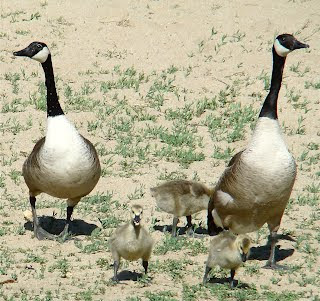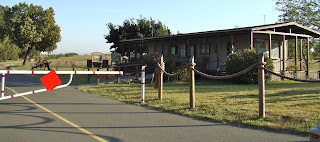


After visiting
Point Cabrillo Light Station in the morning, Patty and I drove one mile down a windy but scenic Mendocino road to
Russian Gulch State Park for a picnic lunch and a long hike. We passed a curvaceous bridge, and stopped at the park en-trance to pay our day use fee.
Before proceeding, we had a small problem that we hoped the ranger could help us with. The cap on our bottle of fruit juice had been screwed on too tightly at the factory. We couldn't open it. The ranger was a strong, burly fellow who was happy to help a couple of senior citizens with their dilemma. We watched as his face turned purple with effort, and finally - success!
He handed us a trail map. He didn't know if the park was staying open or not. I've found that the staff is often the last to know. We drove in, hoping to find a scenic spot for our picnic. Yes, I think this view will suffice!
Russian Gulch has several major features: a waterfall, a blow-hole and Fern Canyon. There are wildflowers galore, picnic sites, campsites, a beach and up to ten miles of hiking trails.


The blow-hole was a five minute walk from our picnic table, although as we often do, we easily tripled that amount of time by stopping to take pictures. A narrow path has been cut through the shoulder-high foliage. Sweet scented Cow Parsnip and bright red Mendo-cino Paintbrush dominated the wild-flowers on the blow-hole bluff.
The hole sits two hundred feet back from the edge of cliff. Scotch Broom and coastal plant life cover the walls of this sixty foot deep pit. Below, a tunnel has been formed through the rock by the constant pounding of waves against the headlands. At high tide you can hear the sound of the water rushing through the tunnel like a freight train before it reaches its final destination at the bottom of the hole.


Next up was our hike. We followed a paved road for half a mile, through a few campsites, to the start of The Fern Canyon Trail. Hillsides were covered with the familiar Sword Fern surrounding Redwood Trees. We learned that the intriguing large clumps of wispy, spiky ferns with striped, bamboo-like stalks are called Horsetail Ferns.



I am often amazed how drastically the landscape and foliage can change in a matter of minutes. We had just left the marine headlands, and were now almost smothered by a dense redwood and fern jungle. I love California!
Russian Gulch was acquired in 1933 through gifts of money and land by A. Johnston and the County of Mendocino to match State Park funds. It is believed that the first white men to explore the rugged Mendocino coastline were Russian, hence the name to honor these early adventurers.

Our hike continued into the woods, with endless varieties of wildflowers, blackberries, and some sort of berry bush that we hadn't seen before: a
Salmonberry!

The trail became steeper as we traveled further inland, but rewarded us with a foot-bridge leading to a thirty-six foot waterfall. Benches provided rest and an opportunity to be hypnotized by the falling water.


At this point we took a wrong turn on the path. Instead of looping back, we ended up on a service road on the peri-meter of the park. And while it added two to three miles to our journey, it was flat and easy walking. Once we realized our error, we could easily see where we were on the map. And lest we had any doubts, the road had well placed signposts with mileage and arrows.
On this back road there was new, different foliage to look at. We had entered yet another micro-environment. We were out of the forest and had blue sky overhead.

Best of all, wild pink Rhododendrons accompanied us the entire way. Russian Gulch State Park has easily slipped into my top ten favorites list!
I hope to see you at the State Parks.
Lucy
 This blog is dedicated to the memory of my Father, who loved reading maps, exploring alternate routes, and taking the road less traveled.
This blog is dedicated to the memory of my Father, who loved reading maps, exploring alternate routes, and taking the road less traveled.
Alvin David Dick
April 28, 1926 - May 20, 2012


 I drove southwest for twenty miles down country back roads lined with almond orchards from McConnell SRA to George Hatfield State Recreation Area. Hatfield is the last of the four San Joa-quin valley state recreation areas on the closure list, and like McConnell, will be remaining open.
I drove southwest for twenty miles down country back roads lined with almond orchards from McConnell SRA to George Hatfield State Recreation Area. Hatfield is the last of the four San Joa-quin valley state recreation areas on the closure list, and like McConnell, will be remaining open.



 In February Deidre Kelsey, District 4 Supervisor for Merced County, gave $2,500 of her special district funds as seed money for the Save Our River Parks group. Additional funds include $5,000 from the city of Newman, a $10,000 special district fund loan from Merced County and $20,000 from the State Parks Founda-tion. Several small donations from $20 to $100 also helped the group reach its goal.
In February Deidre Kelsey, District 4 Supervisor for Merced County, gave $2,500 of her special district funds as seed money for the Save Our River Parks group. Additional funds include $5,000 from the city of Newman, a $10,000 special district fund loan from Merced County and $20,000 from the State Parks Founda-tion. Several small donations from $20 to $100 also helped the group reach its goal.


















































